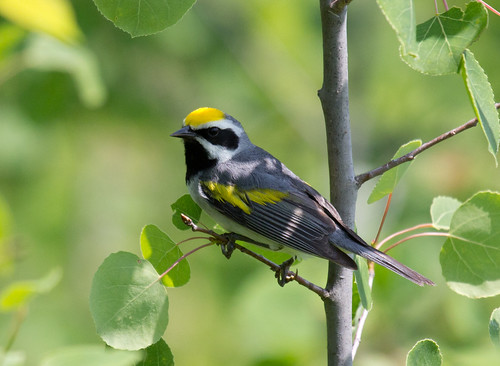The once common Golden-winged Warbler now has one of the smallest populations of any songbird not on the Endangered Species List.
An estimated 400,000 breeding adults remained in 2013—a drop of 66 percent since the 1960s, based on Breeding Bird Survey numbers. This survey, which focuses on males singing on territories, began in 1966; we have no comparable data to fill in what happened with populations before that year.
 |
| Golden-winged Warbler, Survey-wide |
In the Appalachian Mountains, where the number of individuals counted on each Breeding Bird Survey Route was very high when the Survey began in the 1960s (almost 3 counted on average per survey route), the situation is beyond critical: the regional population there has fallen by 98 percent. If the species had a "surplus population" with any uncounted "floaters," (males not singing because they didn't hold a territory), they'd already disappeared before the dramatic declines shown on Breeding Bird Surveys.
 |
| Golden-winged Warbler, Appalachians |
In 1966, New Hampshire numbers of Golden-winged Warblers were quite low--whether they had been in previous decades can't be determined. Their numbers were relatively high in 3 individual years of the Survey, but each of those was a genuine outlier.
The Breeding Bird Survey Summary and Analysis webpage does not list the species at all for either Maine or Vermont, New Hampshire's two neighboring states.
 |
| Golden-winged Warblers have been spotty at best as far north as New Hampshire. |
Pennsylvania reaches fairly far west for an Eastern Seaboard state. Golden-winged Warbler numbers were more robust at the start of the Breeding Bird Survey, but have declined dramatically.
 |
| Golden-winged Warblers declined rapidly since the start of the 70s in Pennsylvania |
New York State's numbers started lower than those of Pennsylvania, and the decline has been quite steady.
 |
| New York started with a smaller population than Pennsylvania in the 60s. |
Michigan's Golden-winged Warbler population was comparable to Pennsylvania's in 1966, and the downward trend was very similar.
 |
| Michigan started with a population comparable to Pennsylvania's. The decline was slower. |
In 1966, Wisconsin's population was about at the level of that in the Appalachian Mountains. The decline was less noticeable in the early 70s, but since then the decline has been quite noticeable.
 |
| Wisconsin's population of Golden-winged Warblers declined slowly at first, but now is growing dire. |
Minnesota, the state at the western end of the Golden-winged Warbler's range, has the most robust population of them right now, with no show yet of a decline.
 |
| The furthest West state with breeding Golden-winged Warblers, the decline is not yet being noticed here, with current numbers comparable to Wisconsin's in the 1970s. |
In Ontario, at the northern end of their range, numbers have been fairly steady.
 |
| Golden-winged Warbler population in Ontario. |
Manitoba used to be further north than Golden-winged Warblers reached. Might they be extending their range north with climate change? Or might it be changes in forestry practices?
 |
| Golden-winged Warbler population in Manitoba. |










